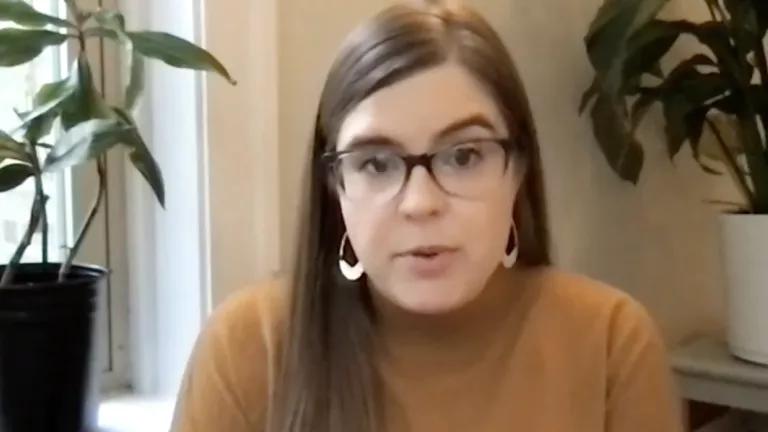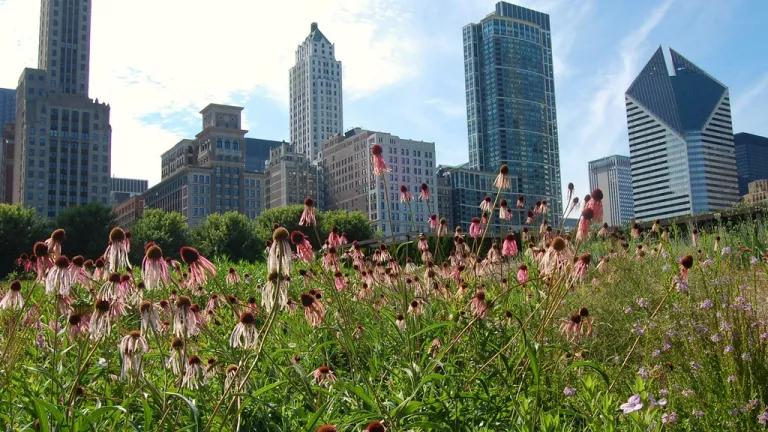The Need for Green Schools on Chicago's SE Side
A strategy truly focused on equity should include prioritizing buildings and schools in environmental justice communities like the Southeast Side.

George Washington High School teachers advocating for clean schools this Earth Day
Co-authors: Marcelina Pedraza, Local School Council Chair for George Washington Elementary School and Donald Davis, Social Science Teacher at George Washington High School
George Washington Elementary and High School Students deserve better.
Living on the Southeast Side of Chicago, the students are all too familiar with industrial pollution. They know the city has treated their home as “a garbage dump” because they’ve seen it firsthand. Before turning 18, they’ve already had to face General Iron, a notorious scrap metal recycling plant that planned to move across the street from GWHS. And though they saw victory against the polluting facility, they still fight a battle every day inside their own schools.
While they’ve fought to be able to breathe clean air in their community, they still don’t have central air inside the high school. The high school students deal with asbestos, lead, and an overcrowded building that barely fits its 1,500 students and staff. And the elementary school lacks an auditorium to hold assemblies and utilizes the lunchroom for gatherings. Without central air, the lunchroom and auditorium are considerably uncomfortable to be in during the school year.
Residents and advocates are calling on Chicago Public Schools (CPS) to make good on its climate action promises by investing in two carbon-neutral, environmentally friendly school buildings and athletic facilities in the 10th Ward.
“Both George Washington Elementary School and George Washington High School on Chicago's Southeast Side have outdated buildings with poor ventilation, limited space for athletics and assemblies, and they represent a lack of care from the city of Chicago and the Board of Education for achieving equity for our neighborhood schools,” a petition for the new school buildings says. “While the board has invested more than $100 million for Jones College Prep, and $50 [million] for John Hancock College Prep, the two neighborhood school buildings for the 10th Ward both require updated ventilation, working windows, new tiles, faucets not containing lead, and an environment to overcome the higher rates of asthma on the Southeast Side.”
In 2020, the Chicago Teachers Union (CTU) passed a resolution for a CTU Green Schools Campaign to address the climate crisis and environmental racism, improve school buildings, and provide green careers for the community. The resolution called for the mayor and CPS to invest in:
- Green and healthy buildings
- Retrofit and weatherize buildings
- Remediate schools for lead, asbestos, and mold
- Install efficient electric or geothermal HVAC
- Install new ventilation for COVID-19 and energy recovery
- Install solar panels and source 100 percent renewable energy
- Green jobs and environmental justice
- Work with unions to train and hire CPS parents
- Provide cooling centers and electricity to communities during heat waves, disasters, and power outages
- Prioritize the communities hit hardest by COVID-19, environmental racism, and systemic disinvestment
- Climate and sustainability education
- Support climate justice curriculum across the grade levels
- Expand solar energy career programs already in place at Benito Juarez High School and Prosser Career Academy
- Implement school composting programs, community gardening, and other sustainable practices
These upgrades would change the lives of students and faculty across the city and specifically in the 10th Ward, where pollution from more than 100 years of industry has left them with poor land, water, and air quality.
The petition also comes at a time when the city of Chicago is working to address the 70 percent of greenhouse gas emissions that come from buildings across the city. Last June, Mayor Lori Lightfoot announced a Building Decarbonization Working Group to craft recommendations and chart a course that will dramatically reduce the emissions from the built environment and further a green economic recovery in Chicago. The group is now recommending policies and programs for “an equity-focused building emission-reduction strategy that lowers economic burdens on residents and businesses, reduces energy insecurity for communities of color, and uses an equity lens to assess the cost and impact of these strategies.”
A strategy truly focused on equity should include prioritizing buildings and schools in environmental justice communities like the Southeast Side. As we chart a just transition from fossil fuels to clean energy across the state, let’s not forget about the students in the 10th Ward whose lives have been shaped by industry infiltrating their community. They deserve to grow up in a breathable neighborhood, not a toxic sacrifice zone. We don’t want them to see their neighborhood as the city’s garbage dump.
Let’s start by making sure they have a healthy environment in the school buildings where they spend eight hours each day.




